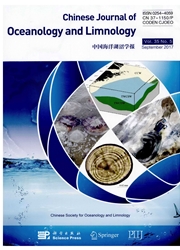

 中文摘要:
中文摘要:
为了了解海带受精时间和孢子囊形成的关系,以B013品系为材料,在2014-2015年度,先后在5月、6月、7月和8月,四次完成受精,培育了B013幼苗,并在大连旅顺海带栽培区开展了栽培试验。结果表明,5、6月份培育的藻体,分别有100%和80%的藻体在1月中旬开始在顶端1/3处形成首批宽度6 cm左右,长度50~60 cm左右的孢子囊群,这些孢子囊在随后的3个月中,逐渐释放了孢子,并随着藻体的不断生长,孢子囊形成区域的藻体逐渐褪去,到了9月中、下旬,藻体全部区域形成第二批孢子囊群;7、8月份培育的藻体没有在冬季形成首批孢子囊,藻体持续生长,只在9月中、下旬,在藻体的全部,形成了唯一的一次孢子囊群。所有从首批、次批孢子囊释放出来的游孢子经过附着、后期培育测试,都能够正常的形成健康的幼孢子体。这些结果表明,B013孢子囊形成规律不同于双亲中的栽培种群父本,而更加像野生的母本,总是在藻体生长到一定程度时候,在顶端先少量形成孢子囊群,之后在秋天日照时间变短,海水温度开始下降的时候大批量形成孢子囊群,藻体随后流失。该研究结果为后续研究B013孢子囊的形成机制提供了一定的理论依据。
 英文摘要:
英文摘要:
In order to understand the relationship between fertilization time and sporogenesis, this paper took B013 line as material and completed fertilization for 4 times in May, June, July and August, respectively, during 2014- 2015, and got B013 seedling, then conducted cultivation experiment at Lvshun, Dalian seaweed cultivation area. Results showed that 100% of the May group and 80% of the June group formed 6 cm wide and 50 cm long sorus in the apical one-third zone of the blade starting in mid January. During the following 3 months, these sporangia gradually released zoospores with the continuous elongation of algal blade and the apical tissue died off gradually. Blade-wide formation of sorus occurred for the second time in mid or late September. However, the July and August groups did not form any sorus until mid and late September, together with the May and June groups. Zoospores released from sorus forming both in January and September were able to develop into normal and healthy gametophytes. These results suggested that sorus formation of cultivar B013 was different from its male parental plant derived from the farmed population, but rather similar to its female parental plant derived from the wild population, which always formed small sorus firstly in the winter at the apical zone, then in the entire blade in September for the second time when seawater temperature drops and the day becomes shorter. The results would provide certain theoretical reliance for further studying on formation mechanism of BO13 sporangium.
 同期刊论文项目
同期刊论文项目
 同项目期刊论文
同项目期刊论文
 Complete mitochondrial genome of the brown alga Sargassum fusiforme (Sargassaceae, Phaeophyceae): ge
Complete mitochondrial genome of the brown alga Sargassum fusiforme (Sargassaceae, Phaeophyceae): ge Intraspecific genetic analysis, gamete release performance,and growth of Sargassum muticum (Fucales,
Intraspecific genetic analysis, gamete release performance,and growth of Sargassum muticum (Fucales, Complete mitochondrial genome of the brown alga Sargassum hemiphyllum ( Sargassaceae, Phaeophyceae):
Complete mitochondrial genome of the brown alga Sargassum hemiphyllum ( Sargassaceae, Phaeophyceae): Complete mitochondrial genome of the invasive brown alga Sargassum muticum (Sargassaceae, Phaeophyce
Complete mitochondrial genome of the invasive brown alga Sargassum muticum (Sargassaceae, Phaeophyce Isolation and characterization of eight novel microsatellite loci from the brown alga Sargassum horn
Isolation and characterization of eight novel microsatellite loci from the brown alga Sargassum horn Intraspecific genetic analysis, gamete release performance, and growth of Sargassum muticum (Fucales
Intraspecific genetic analysis, gamete release performance, and growth of Sargassum muticum (Fucales Biological identification and determination of optimum growth conditions for four species of Navicul
Biological identification and determination of optimum growth conditions for four species of Navicul Novel means for variety breeding and sporeling production in the brown seaweed Undaria pinnatifida (
Novel means for variety breeding and sporeling production in the brown seaweed Undaria pinnatifida ( Construction of a high-density genetic map and mapping of a sex-linked locus for the brown alga Unda
Construction of a high-density genetic map and mapping of a sex-linked locus for the brown alga Unda Intraspecificcrossing of Saccharina japonica usingdistantly related unialgal gametophytes benefits k
Intraspecificcrossing of Saccharina japonica usingdistantly related unialgal gametophytes benefits k 期刊信息
期刊信息
